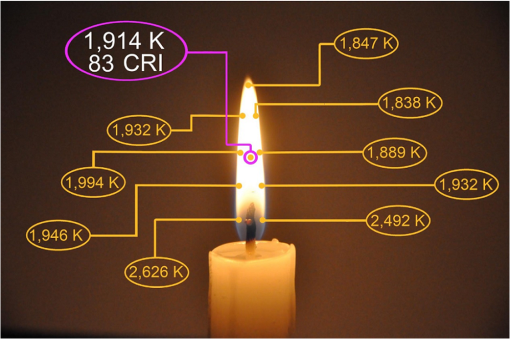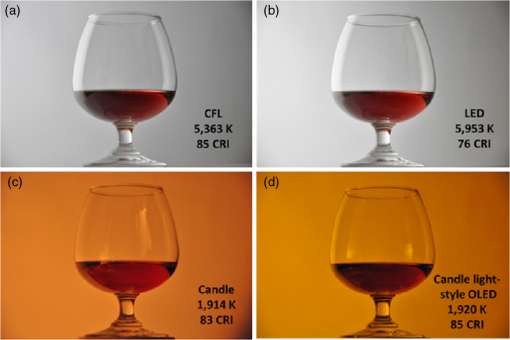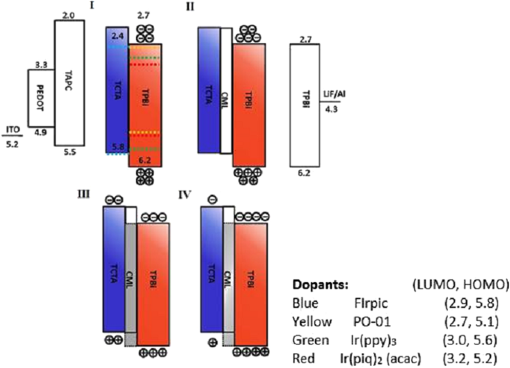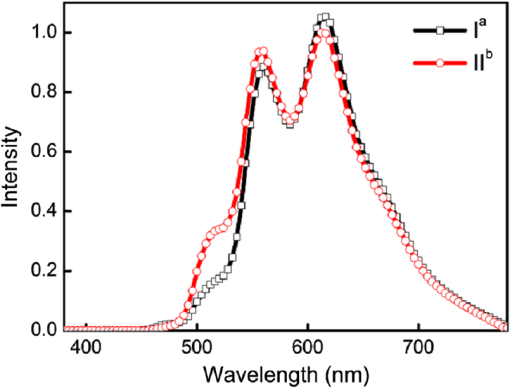|
|
1.IntroductionLatest studies on light sources mainly focus on the development of energy-saving and environmentally friendly illumination devices. 1 Amongst, light-emitting diode (LED) and organic light-emitting diode (OLED) solid-state lighting 2 – 6 technologies have already achieved power efficiency (PE) near to that of fluorescent tubes. However, researchers have rarely focused on developing physiologically friendly light sources, especially for use at night. Color temperature (CT) of light plays an important role in human physiology and psychology. 7 – 14 Numerous studies have shown that high CT-lighting source and intensive white light or light with strong-blue emission drastically suppresses the secretion of melatonin (MLT), an oncostatic hormone. Importantly, the lack of MLT due to frequent exposure to intense light at night can increase the risk of breast, colorectal, and prostate cancers. 10 Suppression of MLT secretion has been reported upon exposure of 3000- or 5000-K fluorescent lights at 200 lx, 15 which is dimmer than the typical 500-lx office lighting, but brighter than the 100-lx lighting used at home. 10 , 15 Much milder suppression can only be observed as the CT is further reduced. The importance of light sources with a low CT can be further realized by the fact that candlelight, which exhibits a CT around 1900 K is capable of creating romantic atmosphere during dinner time. 16 The pleasant sensation may originate from the naturally occurring MLT secretion, which helps people relax. In cases where lighting is needed, this secretion is less suppressed when dim light with a low CT is applied. 14 , 17 Although the low CT candles may be used as a physiologically friendly lighting measure at night, they are very energy-inefficient, not to mention their potential fire hazard problems, flickering nature, and unpleasant smoke due to incomplete burning. All the other hydrocarbon burning-based lighting devices, e.g., oil, kerosene, or gas lamps, are not energy-saving either. Over the past 150 years, many electricity driven lighting technologies have emerged, 2 – 5 and energy efficient lighting tools have become possible. Lighting up the dark energy efficiently is no longer a major problem. However, these electrically driven lighting devices show no CT smaller than 2000 K. For example, the lowest CT is around 2500 K for incandescent bulbs, while 3000 or 5000 K for cold- or warm-white fluorescent tubes or compact fluorescent tubes, or 3000 or 5000 K for warm- or cold-white LED luminaires. They may be suitable for illumination during the daytime or at work, but apparently not for use at night. The true problems have actually arisen from the overuse of bright white light at night. Developing a new lighting source with low CT for reduced MLT suppression is hence no less urgent or less important than achieving an even higher lighting efficacy. We demonstrate a candlelight style OLED device with a yellowish orange emission with Commission International de l’Eclairage (CIE) 1931 coordinates tunable around (0.52, 0.43) with a CT of 2000 K, closely matching the (0.52, 0.42) and 1914 K of a white candle studied. The resulting emissive spectrum shows an 80% similarity with that of the candle. The candlelight style OLED exhibits a efficacy and a 93 color rendering index (CRI) while the efficacy is and CRI 83 for candles. Furthermore, candlelight has a CT varying with the variation in emissive flame position, as seen in Fig. 1. The color temperature ranges from 1847 to 2626 K, with a 1914 K at the brightest spot. Fig. 1Candle shows different color temperatures (CTs) at different positions inside the flame. The CT varies from 1847 to 2626 K for the white candle studied herein. To represent, the CT of the brightest spot is chosen, which is 1914 K (Ref. 18).  2.Experiment2.1.Device Structures and Fabrication of Candlelight Style OLEDsEach device consisted of a 125-nm indium tin oxide layer, a 35-nm poly(3,4-ethylene-dioxy-thiophene)-poly(styrenesulfonate) (PEDOT:PSS) hole-injection layer, a 20-nm di-[4-(N,Nditolylamino)-phenyl]cyclohexane (TAPC) electron-confining layer, an 5-nm-short wavelength emissive-layer, a 15-nm-long wavelength emissive-layer, a 32-nm 1,3,5-tris(N-phenylbenzimidazol- 2-yl)benzene (TPBi) electron transporting layer, a 0.8-nm lithium fluoride (LiF) layer and a 150-nm aluminum layer; short wavelength emissive-layer is 4,4′,4′′-tri(N-carbazolyl)triphenylamine (TCTA) doped with 20% bis[3,5-difl uoro-2-(2-pyridyl)phenyl]-(2-carboxypyridyl) iridium(III) (Firpic). The long wavelength emissive-layer consisted of a 1,3,5-tris(N-phenylbenzimidazol-2-yl)benzene (TPBi) host doped with 12.5% tris(2-phenyl-pyridine) iridium (Ir(ppy)3) green dyes, 3% Iridium(III) bis(4-phenylthieno[3,2-c]pyridinato-N,C 2′)acetylacetonate (PO-01) yellow dye, and 1% bis(1-phenylisoquinolinolato-C2,N) iridium (acetylacetonate) ( ) deep-red dye. The fabrication of the blend interlayer, short wavelength emissive layer and long wavelength emissive layer involved vapor deposition, and the sources were prepared via the solution premixing method. 19 2.2.Device CharacterizationThe current-voltage-luminance characteristics of the resulting phosphorescent yellow OLEDs were measured using a Keithley 2400 electrometer together with a Minolta CS-100 luminance meter. Electroluminance (EL) spectrum and CIE color coordinates were obtained by using a PR 655 SpectraScan spectroradiometer. 3.Results and DiscussionFigure 2 shows the photographs of a red wine containing glass illuminated by different light sources that include the candlelight style OLED, a candle, a compact fluorescent tube, and a LED bulb. A yellowish orange emission was observed as the glass was shone by the candlelight style OLED, closely resembling that shone by the white candle. Whilst, the high CT compact fluorescent tube (5363 K) or LED bulb (5953 K) yielded a cold sensation by the white emission. Fig. 2Lighting color-temperature effect on the photographic results of a grape-wine containing glass illuminated under different light sources, including (a) a cold white compact fluorescent lamp (CFL) with 5363 K and an 85 color rendering index (CRI), (b) a white light-emitting diode (LED) bulb with 5953 K and a 76 CRI, (c) a candle with 1914 K and an 83 CRI, and (d) the candlelight-style OLED with 1920 K and an 85 CRI. Warm sensation is originated from the candle and the candlelight-style OLED that have relatively low CT, whereas cold sensation is generated from the high CT, CFL, and LED with white emission. 18  Table 1 summarizes the electroluminescent characteristics of the proposed devices. The EQE and PE of the device without an interlayer (Device I) is 16.3% and with a CT of 2361 K and CRI of 64 at . With the adding of a 2-nm TCTA interlayer, the efficiency increased to 17.8% in EQE and , and without a valuable CT and CRI. However, the blend interlayer with a weight ratio of TCTA to TPBi in Device III markedly improved device CRI. Comparing with Device I, the CRI increased from 64 to 84, with a in PE, 8.7% in EQE, and 3371 K in CT increase. Table 1Effect of thickness and composition of a carrier modulation layer (CML) on the device color temperature (CT), candlelight spectrum resemblance, color rendering index (CRI), and power efficiency results (Ref. 18).
The efficiency increased to 14.6% and when the amount of TPBi further decreased in Device IV, and decreased to 12.3% and as the interlayer increased to 2.5 nm for Device V. As the interlayer thickness decreased to 1.5 nm in device VI, the EQE decreased to 12.9%, although the PE of Device VI, which is , is very similar to that of Device III. These three devices show comparatively high CRI, i.e., 93 for Device IV, 93 for Device V, and 83 for VI. Device II exhibits the highest efficiency, and it may be attributed to the electrons confinement effect of the carrier modulation layer (CML), TCTA, due to its relative high LUMO level compared with that of TPBi and forms a significant barrier for electrons to overcome. The energy diagram in Fig. 3 can be used to illustrate this effect. As the use of TCTA as CML, a large amount of electrons are confined in the red and yellow emissive layer, which enables more excitons to generate and hence the device efficiency increased. Fig. 3Schematic illustration of candlelight style OLEDs without an interlayer (Device I), and with a neat TCTA interlayer (Device II). Devices III to VI all had a blend carrier modulation layer (CML), where the thickness was 1.5 nm for Device VI, 2.5 nm for Device V, and 2-nm Devices III and IV. The ratios of TCTA to TPBi in the blend layers of Devices II to VI were , , , , , respectively. This figure also shows the plausible distributions of holes and electrons in the studied devices at the same current density. With the use of a blend interlayer with proper compositions and thicknesses, the entering holes and electrons can be well distributed into the two-emissive zones.  However, either with or without a CML, no blue emission can be observed from the EL spectrum, as Fig. 4. To enable more electrons to inject into the blue-emissive layer, the TCTA-based CML was modified by blending it with an electron-transporting material TPBi, via which electrons can much more freely penetrate from the yellow red emissive layer to blue emissive layer. This enhances the intensity of the blue emission. Although, the blue emission was overly increased due to the presence of a new barrier (0.4 eV) against holes at the interface between the blue emissive layer and the TPBi in the blend CML, and causes too few holes to enter the yellow red emissive zone. Fig. 4Electroluminescent spectra of no and neat CML-composing counterparts. (a) With no CML, (b) a 2-nm neat TCTA as interlayer. All spectra were obtained at .  To enable sufficient holes to inject into the yellow red emissive layer, blend CML was further modified by reducing the amount of TPBi used, which is also effective in electron transporting as mentioned before. This explains why the blue emission markedly decreased when the ratio of TCTA: TPBi employed fell from to , as shown in Fig. 5. The function of the blend CML is also sensitive to the employed thickness. Increase or decrease the thickness of CML, both can lower the device efficiency. This may be because more excitons were generated within the CML, either on TCTA or on TPBi. Although energy transfer can still occur via diffusion of the generated excitons, their effectiveness drastically decreased as the diffusion distance increased, which explains why both the intensities dropped as the CML thickness increase. In case of thinner CML thickness device, no sufficient excitons are generated and diffuse into emissive zone, cause a lower efficiency. 4.ConclusionIn this study, we demonstrate a candlelight style OLED device with a yellowish orange emission with Commission International de l’Eclairage (CIE) 1931 coordinates tunable around (0.52, 0.43) with a CT of 2000 K, closely matching the (0.52, 0.42) and 1914 K of a white candle studied. The candlelight style OLED exhibits a efficacy and a 93 CRI, while the efficacy is and CRI 83 for candles. The high efficiency of the proposed device may be attributed to the employed blend interlayer, which helps effectively distribute the entering carriers into the available recombination zones. These candlelight style OLEDs are an ideal lighting source to safeguard human health, especially for use at night. AcknowledgmentsThe authors would like to acknowledge support from National Science Council and Ministry of Economic Affairs, Taiwan. This work was financially supported in part by grants: NSC101-3113-E-007-001, NSC100-2119-M-007-011-MY3, and MEA 100-EC-17-A- 07-S1-181. References
V. Adamovich
et al.
,
“High efficiency single dopant white electrophosphorescent light emitting diodes,”
New J. Chem., 26
(9), 1171
–1178
(2002). http://dx.doi.org/10.1039/b204301g 1144-0546 Google Scholar
J. Kido
M. Kimura
K. Nagai
,
“Multilayer white light-emitting organic electroluminescent device,”
Science, 267
(5202), 1332
–1334
(1995). http://dx.doi.org/10.1126/science.267.5202.1332 0036-8075 Google Scholar
R. F. Service
,
“Organic LEDs look forward to a bright, white future,”
Science, 310
(5755), 1762
–1763
(2005). http://dx.doi.org/10.1126/science.310.5755.1762 0036-8075 Google Scholar
F. So
J. Kido
P. Burrows
,
“Organic light-emitting devices for solid-state lighting,”
MRS. Bull., 33
(7), 663
–669
(2008). http://dx.doi.org/10.1557/mrs2008.137 0883-7694 Google Scholar
J. H. Jou
et al.
,
“High-efficiency flexible white organic light-emitting diodes,”
J. Mater. Chem., 20
(32), 6626
–6629
(2010). http://dx.doi.org/10.1039/c0jm01348j 0959-9428 Google Scholar
J. H. Jou
et al.
,
“Sunlight-style color-temperature tunable organic light-emitting diode,”
Appl. Phys. Lett., 95
(1), 013307
(2009). http://dx.doi.org/10.1063/1.3176217 0003-6951 Google Scholar
W. J. M. van Bommel
,
“Non-visual biological effect of lighting and the practical meaning for lighting for work,”
Appl. Ergon., 37
(4), 461
–466
(2006). http://dx.doi.org/10.1016/j.apergo.2006.04.009 0003-6870 Google Scholar
L. W. R. Küller
,
“Melatonin, cortisol, EEG, ECG and subjective comfort in healthy humans: Impact of two fluorescent lamp types at two light intensities,”
Light. Res. Technol., 25
(2), 71
–80
(1993). http://dx.doi.org/10.1177/096032719302500203 0024-3426 Google Scholar
P. R. Mills
S. C. Tomkins
L. J. M. Schlangen
,
“The effect of high correlated colour temperature office lighting on employee wellbeing and work performance,”
J. Circadian Rhythms, 5
(2),
(2007). http://dx.doi.org/10.1186/1740-3391-5-2 1740-3391 Google Scholar
S. M. Pauley
,
“Lighting for the human circadian clock: recent research indicates that lighting has become a public health issue,”
Med. Hypotheses, 63
(4), 588
–596
(2004). http://dx.doi.org/10.1016/j.mehy.2004.03.020 0306-9877 Google Scholar
G. C. Brainard
et al.
,
“The Influence of various irradiances of artificial-light, twilight, and moonlight on the suppression of pineal melatonin content in the syrian-hamster,”
J. Pineal. Res., 1
(2), 105
–119
(1984). http://dx.doi.org/10.1111/jpi.1984.1.issue-2 0742-3098 Google Scholar
S. W. Lockley
G. C. Brainard
C. A. Czeisler
,
“High sensitivity of the human circadian melatonin rhythm to resetting by short wavelength light,”
J. Clin. Endocrinol. Metab., 88
(9), 4502
–4505
(2003). http://dx.doi.org/10.1210/jc.2003-030570 0021-972X Google Scholar
F. A. J. L. Scheer
R. M. Buijs
,
“Light affects morning salivary cortisol in humans,”
J. Clin. Endocrinol. Metab., 84
(9), 3395
–3398
(1999). http://dx.doi.org/10.1210/jcem.84.9.6102 0021-972X Google Scholar
M. Sato
T. Sakaguchi
T. Morita
,
“The effects of exposure in the morning to light of different color temperatures on the behavior of core temperature and melatonin secretion in humans,”
Biol. Rhythm Res., 36
(4), 287
–292
(2005). http://dx.doi.org/10.1080/09291010500079734 0929-1016 Google Scholar
T. Kozaki
et al.
,
“Effects of short wavelength control in polychromatic light sources on nocturnal melatonin secretion,”
Neurosci. Lett., 439
(3), 256
–259
(2008). http://dx.doi.org/10.1016/j.neulet.2008.05.035 0304-3940 Google Scholar
C. Potera
,
“The core of the candle problem,”
Environ. Health Perspect., 108
(4), A165
–A165
(2000). 0091-6765 Google Scholar
A. Panzer
,
“Depression or cancer: the choice between serotonin or melatonin,”
Med. Hypotheses, 50
(5), 385
–387
(1998). http://dx.doi.org/10.1016/S0306-9877(98)90209-2 0306-9877 Google Scholar
J. H. Jou
et al.
,
“Candle light-style organic light-emitting diodes,”
Adv. Funct. Mater., 23
(21), 2750
–2757
(2013). http://dx.doi.org/10.1002/adfm.v23.21 1616-3028 Google Scholar
J. H. Jou
et al.
,
“Efficient, color-stable fluorescent white organic light-emitting diodes with single emission layer by vapor deposition from solvent premixed deposition source,”
Appl. Phys. Lett., 88
(19), 193501
(2006). http://dx.doi.org/10.1063/1.2200007 0003-6951 Google Scholar
|
|||||||||||||||||||||||||||||||||||||||||||||||||||||||||||||||||||||||||||


